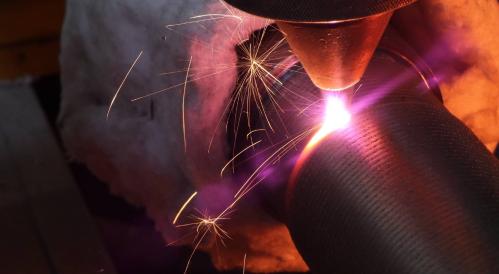Development and research
LaserTherm develops and subsequently manufactures and puts into operation its own new technologies, its own unique process of laser head solutions, its own robotic guidance system and other unique systems and products. Such a comprehensive development focus can be achieved thanks to cooperation with academic institutions, e. g. in cooperation with the Academy of Sciences, with CTU in Prague, with UWB in Pilsen and others. LaserTherm, together with these institutions, has successfully applied for subsidies from the Ministry of Industry and Trade, TAČR, etc., thanks to which it is possible to significantly increase the company's know-how in terms of technology and knowledge.
Start of R&D projects in the TAČR-TREND Program “Technology Leaders”
1) Development of technology of laser cladding of special anticorrosive composite systems based on non-ferrous and natural inorganic materials on inner walls of tubes for application in energy and chemical industry
The project will deal with the development of cladding technology of non-ferrous metals and composite systems with filler from natural inorganic materials.
The motivation of the project is the development of a new robust technology in order to increase the corrosion resistance and durability of key components in the energy and chemical industry. One of the main results of the project will be a prototype of a process laser head for creating cladding and layers on inner walls of tubes with a diameter of tens of millimeters and lengths of meters. Another non-standard specific feature will be the use of high-power lasers with a wavelength up to 550 nm, which will ensure maximum process efficiency when cladding copper-based material systems.
From a commercial point of view, the main goal is the realization of a robotic workplace for use in production orders, or possibly as a turnkey delivery to the customer.
The co-researcher is the University of West Bohemia in Pilsen.
2) Development of new welding methods for heterogeneous joints based on steels, Al-alloys and Ni-alloys.
LaserTherm wants to follow up with the successful implementation processes of modern laser technologies and use this experience and references to apply the newly developed methods of creating heterogeneous weld joints using laser or friction welding using laser pre-weld line cleaning.
The heterogeneous weld joints that need to be formed in the energy, rail, aerospace and chemical-food industries represent geometric and structural (metallurgical) discontinuities. Geometric discontinuity is often caused by manufacturing inaccuracies and defects. Metallurgical discontinuity is often caused by a connection between ferritic steel and austenitic steel, or between austenitic steel and an Al-alloy, or between austenitic steel and a Ni-alloy, or between different Al-alloys.
Due to their properties, heterogeneous weld joints significantly reduce the lifetime of the systems and equipment in which they are implemented, but their occurrence and use can often not be eliminated for physical or mechanical reasons. These are some of the most critical parts of various systems, constructions and components that receive a special worldwide attention.
Laser processing heads
In order to improve the existing optical quality of our heads and to create a highly sophisticated and unique optical configuration solution, we decided to establish cooperation with the TOPTEC research organization under the Academy of Sciences at the beginning of the year 2015. This organization is involved in the research and development of optical components for the most demanding scientific and technical applications. We believe that this cooperation will bring a significant enrichment to our existing solution and will ultimately have a positive impact on both the quality and functionality of the final products and their cost.
Seam tracking systems
Due to the high demands on the accuracy of laser welding, LaserTherm has developed its own automatic robot guidance system, more precisely scan heads for weld seams, in cooperation with the University of West Bohemia in Pilsen. The automated robot guidance system uses a laser profilometer to locate the seam and an algorithm to quickly adjust the trajectory of the robot, respectively scan head beam position. The system can eliminate inaccuracies in the weldment position caused by the jig or deformations during welding. It is primarily intended for laser / conventional welding applications, but it can be extended to other robotic technologies such as laser hardening or cladding.
additive and hybrid production
In cooperation with Kovosvit MAS and CTU in Prague, we are developing a laser system for additive and hybrid production. It is a development of control and CAD system and a mechanical modification of CNC machine consisting of incorporating a laser source with laser process optics. We will be able to offer our customers the production of unique parts that cannot be produced by conventional methods thanks to this system.
New technology for intelligent robot movement planning in industrial processes
We are developing the technology for intelligent planning of robot movement in cooperation with the University of West Bohemia in Pilsen. This technology will provide an alternative intuitive solution for industrial robot programming, enabling programming not only for robotic system specialists, but also for current employees of our customers. This technology should greatly facilitate the transition towards robotization of medium and small business technology operations, shorten the time and cost of robot programming (not only) by specialists (integrators), and allow available transfer of long-term experience of technology process specialists to robotized operations.
Laser technology for cladding of leading edges of blades
We are developing and implement laser technology for cladding of the leading edges of blades for turbines in cooperation with Doosan Škoda Power. It is a unique technology that improves properties such as blade efficiency and durability, thus saving customers' financial resources.



